What is it like to drive in Panama?
Roy Cannon - Gestoria Cocle - main office in Penoneme
Driving in Panama is a real adventure, scary initially, frustrating for sure in Panama City, but better by far than taking taxis. Essentially it comes down to culture. Panamanians do not share a lot of the traditions that drivers from Northern America and Europe take for granted. In addition there are few street signs, and those often do not match what appears on road maps, which also are like hen's teeth, hard to find. There is a movement to install GPS systems...
Driving in Panama is a real adventure, scary initially, frustrating for sure in Panama City, but better by far than taking taxis. Essentially it comes down to culture. Panamanians do not share a lot of the traditions that drivers from Northern America and Europe take for granted. In addition there are few street signs, and those often do not match what appears on road maps, which also are like hen's teeth, hard to find. There is a movement to install GPS systems and these are an improvement, but still have a way to go.
Rules: Don't expect the other drivers to pay attention to signs, rules of right of way, or to be courteous. The attitude is pretty much "me first" and don't be surprised to have people pass you on the road shoulder, push their way in from a side street, especially if you are in one of the traffic jams that are endemic in Panama City. If you come up against a yellow car (taxi) or an old American school bus, perhaps decorated with colorful drawings, back off....and save your paint job, let them do what they want to.
Tailgating is endemic and a large portions of accidents that happen are rear end collisions. Not much you can do about this except to keep your traditional distance from the car in front of you. But be prepared to have people jump into the space you have provided, and of course, no turn signal should be expected when a car changes lanes.
Taxis and the school busses (and even some trucks) are not bothered if they drive at night with no rear taillights functioning, and the police don't seem to care either. Pedestrians do NOT walk on the left facing traffic, but prefer to walk with their backs facing traffic. Seldom do they carry a light at night and dark clothing is frequently worn....but if you do end up with an unfortunate incident, you will be to blame. I have even found people sleeping on the road, and frequently groups will sit on the road in the early evening to catch the breeze....slowly, slowly is the prudent way to drive.
Traffic police enjoy stopping people for infractions that have an expensive fine attached, $75 and up. The most "popular" infractions are speeding (more than 10 kms per hour over the limit) - using radar guns, and spotting someone driving with a cell phone next to your ear. They don't have to roam about, and it is very infrequent that mobile patrols will stop a car, they prefer a shady place next to the highway, or on a busy street corner in the city...good hunting grounds. Often a $20 bill folded up with your license works as a "get out of jail free card", but only if the policeman (not police woman) is working alone, this is a sensitive issue so diplomacy is best advised. By the way, radar detectors are illegal, but nobody I know has ever been stopped for having one, and they work well.
Having painted a sad picture of driving in Panama, you will enjoy the countryside more than the city (less traffic and people are more polite), there are beautiful villages down back roads waiting to be explored, so look at the problems as "local color" and enjoy your trip, but take things easy and keep your cool when somebody blocks the intersection, cuts you off or jumps a stop sign.
Posted April 16, 2013
Judith Tovar - Easy Travel Panama
Driving in Panama City is a challenge specially now that we are building a lot of overpasses and a metro in Panama City.
I recommend that if you want to start driving in Panama City you practice going from one place to another on Sundays..that is the "only" day when there is hardly any traffic in Panama City.
Until you get used to the directions I do "not" recommend you drive in Panama City.
If you...
Driving in Panama City is a challenge specially now that we are building a lot of overpasses and a metro in Panama City.
I recommend that if you want to start driving in Panama City you practice going from one place to another on Sundays..that is the "only" day when there is hardly any traffic in Panama City.
Until you get used to the directions I do "not" recommend you drive in Panama City.
If you want to drive on the Pan-American Highway towards the Pacific beaches..that is "not" a problem..as there is only one way to go..and the highway is fantastic.
Posted May 6, 2013
Nelson Vega
Another factor that makes driving in Panama City difficult is the lack of street nomenclature. In the city downtown (Marbella, San Francisco, Paitilla, Bella Vista), the streets have a name but they also go by a number, or a nick name (Tumba Muerto = Ricardo J. Alfaro, Transistmica = Simon Bolivar, Calle 50 = Nicanor De Obarrio). So it is easy and important to learn the names because not always do they go by what you would see on the map, much less on the signs that would really...
Another factor that makes driving in Panama City difficult is the lack of street nomenclature. In the city downtown (Marbella, San Francisco, Paitilla, Bella Vista), the streets have a name but they also go by a number, or a nick name (Tumba Muerto = Ricardo J. Alfaro, Transistmica = Simon Bolivar, Calle 50 = Nicanor De Obarrio). So it is easy and important to learn the names because not always do they go by what you would see on the map, much less on the signs that would really come up handy when driving.
I also support the idea of getting to know the city first, then starting slowly driving by yourself on the weekends, specially Sunday when there is less traffic.
For the rest of the country, no need to worry. It is easy and much less traffic, unlike PTY.
Posted January 7, 2014
Rafael Alvarado - Rafael Alvarado / Attorney / Real Estate Broker
There are many differences between driving in Panama and driving in the US. We do not have a lot of road signs here in Panama. Back in the day, it was very difficult for a tourist to drive around here. Now that we have GPS, driving is quite easy. Every building has an address but the problem is there are no road signs so you have to look around and make sure that you are on the street that the GPS is telling you that you are on.
In lieu of road signs,...
There are many differences between driving in Panama and driving in the US. We do not have a lot of road signs here in Panama. Back in the day, it was very difficult for a tourist to drive around here. Now that we have GPS, driving is quite easy. Every building has an address but the problem is there are no road signs so you have to look around and make sure that you are on the street that the GPS is telling you that you are on.
In lieu of road signs, people refer to landmarks in giving out directions. So if you ask me how to get from point A to point B, I might say, “Just drive for 150 meters, then turn right once you see the big tree and you will see the house you are looking for.”
That is our culture. We do not work in numbers or avenue names.
You will see a traffic jam in Panama City most of the day and most afternoons but it gets better at night. The streets here in Panama City are a lot more crowded than the streets in the US. Panamanians like using their horns a lot; they use them for everything. That is one reason why Panama City is a very noisy city.
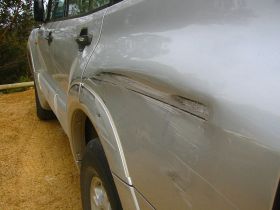
If it is just a dent, you can just talk to the owner of the other car and settle it amongst yourselves. You can offer to take his car to a car shop that you know and pay for the repair. Or, you can ask the owner of the car how much he thinks the repair would cost and you can just pay him the amount in a check or in cash and everything is settled.
You can also go to court or to the authorities, but both parties should prepare the documents in order to present them to the local authorities. Here in Panama, people are used to solving their own problems because it will take longer if you take the case to court. Therefore, people do not like to sue.
Posted October 16, 2014
Antonio Cheng - Romero Realty
Driving in Panama City is awful. People drive like mad in Panama City. Driving here is like driving in New York. People here drive very aggressively, and if you are not used to that kind of driving, your blood pressure will go up to the roof.
Another thing about driving here in Panama City is that there are no street signs. So if you want to go somewhere, you have to know the roads. Not all the streets are numbered and not all of them have signs. You will...
Driving in Panama City is awful. People drive like mad in Panama City. Driving here is like driving in New York. People here drive very aggressively, and if you are not used to that kind of driving, your blood pressure will go up to the roof.
Another thing about driving here in Panama City is that there are no street signs. So if you want to go somewhere, you have to know the roads. Not all the streets are numbered and not all of them have signs. You will either have to use GPS or your cell phone to get around. There are times when traffic re-routing is done due to some roadwork and sometimes these re-routings are not announced. You have to know which roads are closed, which ones are open, and which ones are one-way.
Posted November 4, 2014
Bill Hamilton - Bill Hamilton
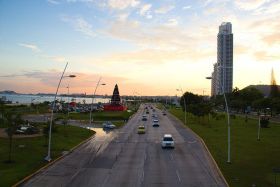 When driving in Panama, someone hoots their horn at you and that’s it. This is in contrast to Europe, where if someone cuts you off, they get angry; they get road-rage. In the States, I hear they’ll even pull out a gun and shoot someone. It is not like that here. They just hoot their horn and that’s it.
When driving in Panama, someone hoots their horn at you and that’s it. This is in contrast to Europe, where if someone cuts you off, they get angry; they get road-rage. In the States, I hear they’ll even pull out a gun and shoot someone. It is not like that here. They just hoot their horn and that’s it. When you drive along the road and there’s police ahead, they always flash their lights to warn you.
... When driving in Panama, someone hoots their horn at you and that’s it. This is in contrast to Europe, where if someone cuts you off, they get angry; they get road-rage. In the States, I hear they’ll even pull out a gun and shoot someone. It is not like that here. They just hoot their horn and that’s it.
When driving in Panama, someone hoots their horn at you and that’s it. This is in contrast to Europe, where if someone cuts you off, they get angry; they get road-rage. In the States, I hear they’ll even pull out a gun and shoot someone. It is not like that here. They just hoot their horn and that’s it. When you drive along the road and there’s police ahead, they always flash their lights to warn you.
I find no problem driving in Panama City, whatsoever. It takes some time getting used to because it is a free for all. No one signals. They will cut in from one lane to the other, right in front of you, so you’ve always got to be aware. You can’t be a hesitant driver in Panama City. You have to be very aggressive. If you can’t get through five lanes of traffic to the other side, when it’s safe, you just got to signal your intentions and just go for it.
In the provinces, driving is fine. There’s no problem at all. You still have to watch for the drivers because they do not signal and they will cut you off, so you have to watch for that. But you’ll get used to it. I find it sort of fun at the moment. It’s like going around Brands Hatch (a racing circuit in England).
Accidents do happen, but not as much as you would think. I can never believe the way people drive here, and I believe it’s because everyone knows that everyone’s going to drive the same, so they have automatic reactions and they’re extra careful. I’ve seen very few accidents here, actually; less than I saw in Spain, and less than I saw in England.
If you get into an accident, normally, you would ring the police and they come along. You get your insurance form and you fill out your form and swap information with the other driver and inform your insurance company straight away. It is the same as anywhere in the world.
Posted December 12, 2014
Bill Hamilton - Bill Hamilton
I find no problem driving in Panama City whatsoever. It takes some getting used to because it’s a free for all. No one signals. They will cut in from one lane to the other right in front of you so you’ve always got to be aware. You can’t be a hesitant driver in Panama City. You have to be very aggressive. If you can’t get through five lanes of traffic, to the other side, when it’s safe you just got to signal and go.
In...
I find no problem driving in Panama City whatsoever. It takes some getting used to because it’s a free for all. No one signals. They will cut in from one lane to the other right in front of you so you’ve always got to be aware. You can’t be a hesitant driver in Panama City. You have to be very aggressive. If you can’t get through five lanes of traffic, to the other side, when it’s safe you just got to signal and go.
In the province, driving is fine. There’s no problem at all. You still have to watch for the drivers because they do not signal and they cut you off so you have to watch for that but you’ll get used to it. I find it sort of fun at the moment. It’s like going around Brands Hatch (a racing circuit in England).
Accidents do happen but not as much as you would think. I can never believe the way people drive here and I believe it’s because everyone knows that everyone’s going to drive the same so they have automatic reactions and they’re extra careful. I’ve seen very few accidents here actually; less that I saw in Spain and less that I saw in England.
If you get into an accident, normally, you ring the police and they come along. You get your insurance form and you fill out your form and swap information with the other driver and inform your insurance company straight away. It is the same as anywhere in the world.
Posted February 2, 2015
Eddie Montes - Panama Property Rentals
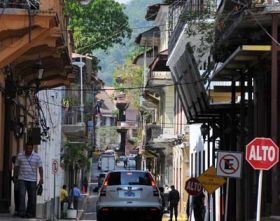 My children describe driving in Panama City as being in a video game! It seems that most of the traffic signals here in Panama such as stop, yield, etc., are merely suggestions and not necessarily a rule of law. People do generally respect streetlights so they will stop at a red light but everything else is fair game.
My children describe driving in Panama City as being in a video game! It seems that most of the traffic signals here in Panama such as stop, yield, etc., are merely suggestions and not necessarily a rule of law. People do generally respect streetlights so they will stop at a red light but everything else is fair game. Driving in Panama can be a little bit hectic but at the same time, the movement of the cars is fluid. There are traffic jams in rush hour...
 My children describe driving in Panama City as being in a video game! It seems that most of the traffic signals here in Panama such as stop, yield, etc., are merely suggestions and not necessarily a rule of law. People do generally respect streetlights so they will stop at a red light but everything else is fair game.
My children describe driving in Panama City as being in a video game! It seems that most of the traffic signals here in Panama such as stop, yield, etc., are merely suggestions and not necessarily a rule of law. People do generally respect streetlights so they will stop at a red light but everything else is fair game. Driving in Panama can be a little bit hectic but at the same time, the movement of the cars is fluid. There are traffic jams in rush hour that are exacerbated by afternoon rains during the rainy season but for the most part, driving is described by some people as a contact sport. It’s a little bit crazy but it is something you would definitely get used to if you do need to get a car and move yourself on your own.
Once you get out of Panama City, there is typically less traffic. There are fewer roads. People are more respectful of traffic signals, so it is a whole different story once you are outside of the city, itself. Panama City is just so congested. Most jobs are in the city so there are lots of people who travel from the outskirts and the suburban parts of the city into the center of the city during their workdays.
The traffic congestion here in Panama City is different from the traffic congestion in Miami, even though Miami is also congested. There are major highways that are backed up in Miami. In Panama, distances in the city are generally short, whereas a typical commute in Miami could be 30 to 40 miles each way and it could take you an hour to get to your destination, depending on traffic. Here in Panama everything is much closer but you do have to leave some time for fender benders and accidents and general congestion as a whole. It is different because congestion is generally on the side streets and small streets here in Panama, whereas traffic jams in Miami are on the major highways.
(Side street in Panama City, Panama, pictured.)
Posted October 17, 2015
Neil Flemming - VaultMax Global Inc
.jpeg) Drivers in Panama City are a bit impatient and they like their horns. In general, they drive pretty well. Let’s put it this way: I lived in the Middle East. Other than the fact that the people here in Panama like to honk their horn a lot and that they get a little bit impatient, they drive pretty well.
Drivers in Panama City are a bit impatient and they like their horns. In general, they drive pretty well. Let’s put it this way: I lived in the Middle East. Other than the fact that the people here in Panama like to honk their horn a lot and that they get a little bit impatient, they drive pretty well. In the Middle East, it’s like Ben-Hur. That’s the analogy I would use. Mad Max without the costumes; that’s my description of...
.jpeg) Drivers in Panama City are a bit impatient and they like their horns. In general, they drive pretty well. Let’s put it this way: I lived in the Middle East. Other than the fact that the people here in Panama like to honk their horn a lot and that they get a little bit impatient, they drive pretty well.
Drivers in Panama City are a bit impatient and they like their horns. In general, they drive pretty well. Let’s put it this way: I lived in the Middle East. Other than the fact that the people here in Panama like to honk their horn a lot and that they get a little bit impatient, they drive pretty well. In the Middle East, it’s like Ben-Hur. That’s the analogy I would use. Mad Max without the costumes; that’s my description of driving in the Middle East.
Comparing driving in Panama City with London or Frankfurt, Germany, in Germany the driving is extremely orderly. Everyone drives perfectly, parks perfectly, and follows the rules like good Germans. In London, it’s a challenge to get parking. That’s a big problem there. Very orderly driving, though; people generally drive pretty well in London. In London, particularly, there are a lot of one-way roads..
In Panama City, the traffic is very heavy, but only really from 7 AM until 9 AM, and then again from 4 PM until 6 PM. At other times, it’s fine. It’s not usually worse after that or other than that. On Sunday, nobody drives at all. It’s lovely. The city just goes really quiet; no one moves. It really is quite a difference on a Sunday.
How its like to drive outside of Panama City depends where you’re going, I suppose. The roads are a lot better now. They’ve done a lot of work on them, so they’re pretty good. The main Trans-American Highway is pretty good and on the Pacific side of Panama, connects the whole length of the country. It’s not normally congested.
Once you veer off the beaten path, you go off to the Caribbean side, then you’re on little windy roads and you’re just going to have to be careful because they do tend to come around the corners on the wrong side. I’ve noticed that.
(Roads in Panama City at night, pictured.)
Posted November 14, 2015
Denise Patrick - Panama Roadrunner Secure Transport
 Driving in Panama can be chaotic, to say the least. I am always getting calls from our drivers saying there is a back up on the bridge or a demonstration or an accident. Patience is a virtue here in Panama.
Driving in Panama can be chaotic, to say the least. I am always getting calls from our drivers saying there is a back up on the bridge or a demonstration or an accident. Patience is a virtue here in Panama. Rush hour in Panama City is mornings until about 9 a.m, lunch time, and then starting about 3:30 again in the afternoon. Try to avoid the downtown area after 3 p.m. and if you are leaving town for the beaches it is a good idea to be across the...
 Driving in Panama can be chaotic, to say the least. I am always getting calls from our drivers saying there is a back up on the bridge or a demonstration or an accident. Patience is a virtue here in Panama.
Driving in Panama can be chaotic, to say the least. I am always getting calls from our drivers saying there is a back up on the bridge or a demonstration or an accident. Patience is a virtue here in Panama. Rush hour in Panama City is mornings until about 9 a.m, lunch time, and then starting about 3:30 again in the afternoon. Try to avoid the downtown area after 3 p.m. and if you are leaving town for the beaches it is a good idea to be across the bridge before 4 p.m. Sundays after 2 p.m. the traffic is heavy going into the city. Early mornings Monday to Saturday prepare for 2.5 hours from the beaches to the city.
Long weekends and holidays see hundreds of thousands of people leaving the city. Its always a good idea to check the calendar before venturing out.
Be prepared for a different culture of driving. Signals are seldom used and the inside lane of the highways don't mean fast lane. Don't be startled if someone goes by you on the shoulder of the highway.
Getting around in Panama has been a learning curve as many streets have two names and no signs!
Be patient and if you get lost in the city hire a cab driver and follow him to where you are going!
(Panama City, Panama, pictured.)
Posted January 12, 2016
Lori Snow - Condor Tours & Travel, Inc
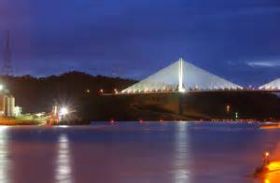 I like to tell my clients when driving in Panama - the stop signs and red lights are only suggestions and the driving laws are optional. Stay away from the bridges during rush hour. Actually stay off the city streets during morning and evening rush hour and on paydays, especially if it falls on Friday or holiday weekend.
I like to tell my clients when driving in Panama - the stop signs and red lights are only suggestions and the driving laws are optional. Stay away from the bridges during rush hour. Actually stay off the city streets during morning and evening rush hour and on paydays, especially if it falls on Friday or holiday weekend.(Centennial Bridge at night, Panama City, Panama, pictured.)
 I like to tell my clients when driving in Panama - the stop signs and red lights are only suggestions and the driving laws are optional. Stay away from the bridges during rush hour. Actually stay off the city streets during morning and evening rush hour and on paydays, especially if it falls on Friday or holiday weekend.
I like to tell my clients when driving in Panama - the stop signs and red lights are only suggestions and the driving laws are optional. Stay away from the bridges during rush hour. Actually stay off the city streets during morning and evening rush hour and on paydays, especially if it falls on Friday or holiday weekend.(Centennial Bridge at night, Panama City, Panama, pictured.)
Posted May 5, 2016
Luis Rossi
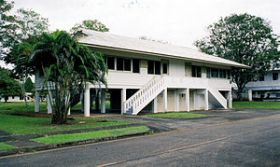 Driving outside of Panama City is very easy and it’s really nice because there are not a lot of cars. The traffic is not heavy at all in the provinces.
Driving outside of Panama City is very easy and it’s really nice because there are not a lot of cars. The traffic is not heavy at all in the provinces. However, it is not the same story if you drive in Panama City. Just like any big city in the world, the traffic in Panama City is horrible so you need to allow ample travel time if you are traveling from one place to another in order for you to arrive at your destination on time.
 Driving outside of Panama City is very easy and it’s really nice because there are not a lot of cars. The traffic is not heavy at all in the provinces.
Driving outside of Panama City is very easy and it’s really nice because there are not a lot of cars. The traffic is not heavy at all in the provinces. However, it is not the same story if you drive in Panama City. Just like any big city in the world, the traffic in Panama City is horrible so you need to allow ample travel time if you are traveling from one place to another in order for you to arrive at your destination on time.
(Bolivar Street in the former Canal Zone, Gatum, Panama, pictured.)
Posted May 13, 2016


